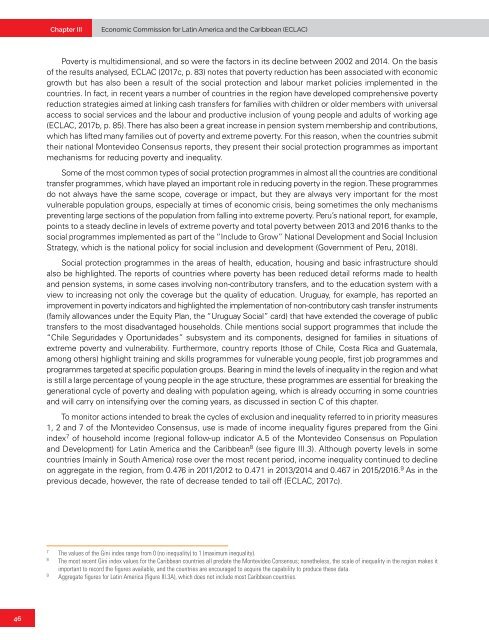Draft first regional report on the implementation of the Montevideo Consensus on Population and Development
This draft report seeks to give an account of progress in the implementation of the priority measures of the Montevideo Consensus on Population and Development in the region, as well as the differences between countries in terms of the degree of implementation. By highlighting relevant national experiences, it also seeks to facilitate the exchange of good practices among countries so that they can benefit from each other in their efforts to advance the implementation of the actions of the Montevideo Consensus.
This draft report seeks to give an account of progress in the implementation of the priority measures of the Montevideo Consensus on Population and Development in the region, as well as the differences between countries in terms of the degree of implementation. By highlighting relevant national experiences, it also seeks to facilitate the exchange of good practices among countries so that they can benefit from each other in their efforts to advance the implementation of the actions of the Montevideo Consensus.
You also want an ePaper? Increase the reach of your titles
YUMPU automatically turns print PDFs into web optimized ePapers that Google loves.
Chapter III<br />
Ec<strong>on</strong>omic Commissi<strong>on</strong> for Latin America <strong>and</strong> <strong>the</strong> Caribbean (ECLAC)<br />
Poverty is multidimensi<strong>on</strong>al, <strong>and</strong> so were <strong>the</strong> factors in its decline between 2002 <strong>and</strong> 2014. On <strong>the</strong> basis<br />
<strong>of</strong> <strong>the</strong> results analysed, ECLAC (2017c, p. 83) notes that poverty reducti<strong>on</strong> has been associated with ec<strong>on</strong>omic<br />
growth but has also been a result <strong>of</strong> <strong>the</strong> social protecti<strong>on</strong> <strong>and</strong> labour market policies implemented in <strong>the</strong><br />
countries. In fact, in recent years a number <strong>of</strong> countries in <strong>the</strong> regi<strong>on</strong> have developed comprehensive poverty<br />
reducti<strong>on</strong> strategies aimed at linking cash transfers for families with children or older members with universal<br />
access to social services <strong>and</strong> <strong>the</strong> labour <strong>and</strong> productive inclusi<strong>on</strong> <strong>of</strong> young people <strong>and</strong> adults <strong>of</strong> working age<br />
(ECLAC, 2017b, p. 85). There has also been a great increase in pensi<strong>on</strong> system membership <strong>and</strong> c<strong>on</strong>tributi<strong>on</strong>s,<br />
which has lifted many families out <strong>of</strong> poverty <strong>and</strong> extreme poverty. For this reas<strong>on</strong>, when <strong>the</strong> countries submit<br />
<strong>the</strong>ir nati<strong>on</strong>al M<strong>on</strong>tevideo C<strong>on</strong>sensus <str<strong>on</strong>g>report</str<strong>on</strong>g>s, <strong>the</strong>y present <strong>the</strong>ir social protecti<strong>on</strong> programmes as important<br />
mechanisms for reducing poverty <strong>and</strong> inequality.<br />
Some <strong>of</strong> <strong>the</strong> most comm<strong>on</strong> types <strong>of</strong> social protecti<strong>on</strong> programmes in almost all <strong>the</strong> countries are c<strong>on</strong>diti<strong>on</strong>al<br />
transfer programmes, which have played an important role in reducing poverty in <strong>the</strong> regi<strong>on</strong>. These programmes<br />
do not always have <strong>the</strong> same scope, coverage or impact, but <strong>the</strong>y are always very important for <strong>the</strong> most<br />
vulnerable populati<strong>on</strong> groups, especially at times <strong>of</strong> ec<strong>on</strong>omic crisis, being sometimes <strong>the</strong> <strong>on</strong>ly mechanisms<br />
preventing large secti<strong>on</strong>s <strong>of</strong> <strong>the</strong> populati<strong>on</strong> from falling into extreme poverty. Peru’s nati<strong>on</strong>al <str<strong>on</strong>g>report</str<strong>on</strong>g>, for example,<br />
points to a steady decline in levels <strong>of</strong> extreme poverty <strong>and</strong> total poverty between 2013 <strong>and</strong> 2016 thanks to <strong>the</strong><br />
social programmes implemented as part <strong>of</strong> <strong>the</strong> “Include to Grow” Nati<strong>on</strong>al <strong>Development</strong> <strong>and</strong> Social Inclusi<strong>on</strong><br />
Strategy, which is <strong>the</strong> nati<strong>on</strong>al policy for social inclusi<strong>on</strong> <strong>and</strong> development (Government <strong>of</strong> Peru, 2018).<br />
Social protecti<strong>on</strong> programmes in <strong>the</strong> areas <strong>of</strong> health, educati<strong>on</strong>, housing <strong>and</strong> basic infrastructure should<br />
also be highlighted. The <str<strong>on</strong>g>report</str<strong>on</strong>g>s <strong>of</strong> countries where poverty has been reduced detail reforms made to health<br />
<strong>and</strong> pensi<strong>on</strong> systems, in some cases involving n<strong>on</strong>-c<strong>on</strong>tributory transfers, <strong>and</strong> to <strong>the</strong> educati<strong>on</strong> system with a<br />
view to increasing not <strong>on</strong>ly <strong>the</strong> coverage but <strong>the</strong> quality <strong>of</strong> educati<strong>on</strong>. Uruguay, for example, has <str<strong>on</strong>g>report</str<strong>on</strong>g>ed an<br />
improvement in poverty indicators <strong>and</strong> highlighted <strong>the</strong> implementati<strong>on</strong> <strong>of</strong> n<strong>on</strong>-c<strong>on</strong>tributory cash transfer instruments<br />
(family allowances under <strong>the</strong> Equity Plan, <strong>the</strong> “Uruguay Social” card) that have extended <strong>the</strong> coverage <strong>of</strong> public<br />
transfers to <strong>the</strong> most disadvantaged households. Chile menti<strong>on</strong>s social support programmes that include <strong>the</strong><br />
“Chile Seguridades y Oportunidades” subsystem <strong>and</strong> its comp<strong>on</strong>ents, designed for families in situati<strong>on</strong>s <strong>of</strong><br />
extreme poverty <strong>and</strong> vulnerability. Fur<strong>the</strong>rmore, country <str<strong>on</strong>g>report</str<strong>on</strong>g>s (those <strong>of</strong> Chile, Costa Rica <strong>and</strong> Guatemala,<br />
am<strong>on</strong>g o<strong>the</strong>rs) highlight training <strong>and</strong> skills programmes for vulnerable young people, <str<strong>on</strong>g>first</str<strong>on</strong>g> job programmes <strong>and</strong><br />
programmes targeted at specific populati<strong>on</strong> groups. Bearing in mind <strong>the</strong> levels <strong>of</strong> inequality in <strong>the</strong> regi<strong>on</strong> <strong>and</strong> what<br />
is still a large percentage <strong>of</strong> young people in <strong>the</strong> age structure, <strong>the</strong>se programmes are essential for breaking <strong>the</strong><br />
generati<strong>on</strong>al cycle <strong>of</strong> poverty <strong>and</strong> dealing with populati<strong>on</strong> ageing, which is already occurring in some countries<br />
<strong>and</strong> will carry <strong>on</strong> intensifying over <strong>the</strong> coming years, as discussed in secti<strong>on</strong> C <strong>of</strong> this chapter.<br />
To m<strong>on</strong>itor acti<strong>on</strong>s intended to break <strong>the</strong> cycles <strong>of</strong> exclusi<strong>on</strong> <strong>and</strong> inequality referred to in priority measures<br />
1, 2 <strong>and</strong> 7 <strong>of</strong> <strong>the</strong> M<strong>on</strong>tevideo C<strong>on</strong>sensus, use is made <strong>of</strong> income inequality figures prepared from <strong>the</strong> Gini<br />
index 7 <strong>of</strong> household income (<str<strong>on</strong>g>regi<strong>on</strong>al</str<strong>on</strong>g> follow-up indicator A.5 <strong>of</strong> <strong>the</strong> M<strong>on</strong>tevideo C<strong>on</strong>sensus <strong>on</strong> Populati<strong>on</strong><br />
<strong>and</strong> <strong>Development</strong>) for Latin America <strong>and</strong> <strong>the</strong> Caribbean 8 (see figure III.3). Although poverty levels in some<br />
countries (mainly in South America) rose over <strong>the</strong> most recent period, income inequality c<strong>on</strong>tinued to decline<br />
<strong>on</strong> aggregate in <strong>the</strong> regi<strong>on</strong>, from 0.476 in 2011/2012 to 0.471 in 2013/2014 <strong>and</strong> 0.467 in 2015/2016. 9 As in <strong>the</strong><br />
previous decade, however, <strong>the</strong> rate <strong>of</strong> decrease tended to tail <strong>of</strong>f (ECLAC, 2017c).<br />
7<br />
The values <strong>of</strong> <strong>the</strong> Gini index range from 0 (no inequality) to 1 (maximum inequality).<br />
8<br />
The most recent Gini index values for <strong>the</strong> Caribbean countries all predate <strong>the</strong> M<strong>on</strong>tevideo C<strong>on</strong>sensus; n<strong>on</strong>e<strong>the</strong>less, <strong>the</strong> scale <strong>of</strong> inequality in <strong>the</strong> regi<strong>on</strong> makes it<br />
important to record <strong>the</strong> figures available, <strong>and</strong> <strong>the</strong> countries are encouraged to acquire <strong>the</strong> capability to produce <strong>the</strong>se data.<br />
9<br />
Aggregate figures for Latin America (figure III.3A), which does not include most Caribbean countries.<br />
46


















